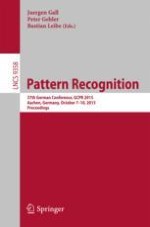2015 | Buch
Pattern Recognition
37th German Conference, GCPR 2015, Aachen, Germany, October 7-10, 2015, Proceedings
herausgegeben von: Juergen Gall, Peter Gehler, Bastian Leibe
Verlag: Springer International Publishing
Buchreihe : Lecture Notes in Computer Science
